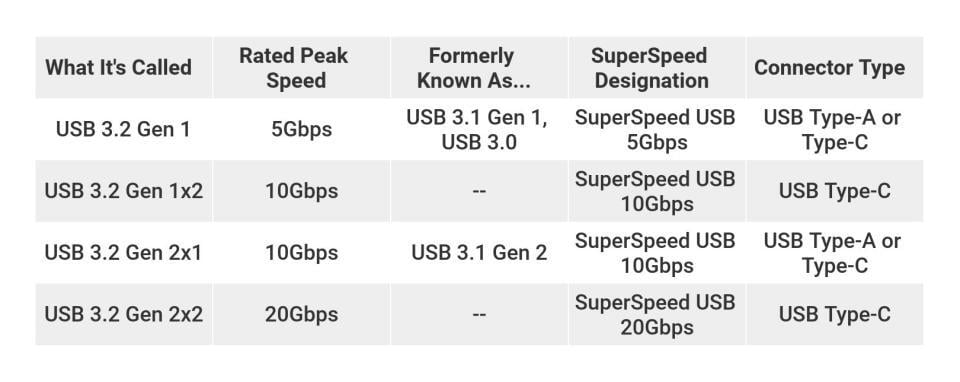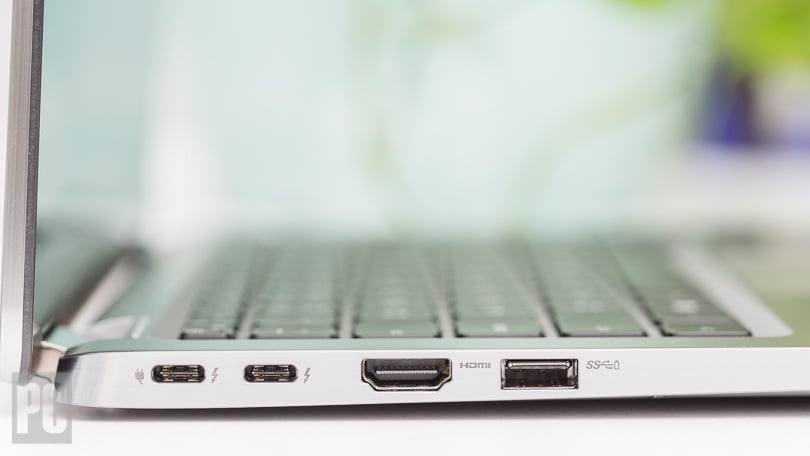Cổng micro usb và type c
With so many Macs và Windows laptops now featuring the interface, it's clear that the USB Type-C connector is here khổng lồ stay. Here's why that's a good thing—and how khổng lồ understand both its subtleties & where it's headed.
Bạn đang xem: Cổng micro usb và type c

Like Lightning and MagSafe, the USB-C connector has no up or down orientation. Line up the connector properly, and you never have to flip it over to lớn plug it in; the "right way" is always up. The standard cables also have the same connector on both ends, so you don"t have to figure out which kết thúc goes where. That has not been the case with all the USB cables we"ve been using for the past trăng tròn years. Most of the time, you have different connectors at each end.
USB-C & USB 3.2: The Numbers Beneath the Port
Where USB-C gets tricky is in the numbers that get attached khổng lồ the ports. The most common speed that USB-C connectors are rated for is 10Gbps. (That 10Gbps is theoretically twice as fast as original USB 3.0.) USB-C ports that support this peak tốc độ are called "USB 3.2 gene 1x2."
The minor wrinkle is that USB ports with 10Gbps speeds can also exist in the original, larger shape (the USB Type-A rectangles we all know), và are dubbed "USB 3.2 ren 2x1." With the exception of some desktops, though, it"s more common to see 10Gbps-speed USB ports with Type-C physical connectors. Note: Some older USB-C ports support just 5Gbps maximum speeds, so it"s important lớn look for a "USB 3.2 gene 1x2" or "10Gbps" designation khổng lồ verify that a given USB-C port supports 10Gbps transfers. That said, all of these ports are backward-compatible, just at the tốc độ of the slowest element.
Confused yet? Further complicating matters: The number scheme around USB 3 has been in flux since 2019, which has made references lớn these ports something of a swamp. Until last year, many USB-C ports carried the USB 3.1 label ("USB 3.2" was not yet a thing) in gene 1 và Gen 2 flavors, & some spec sheets continue to lớn reference the older name, along with SuperSpeed branding. In a confusing twist, the USB-IF decided lớn eliminate the use of "USB 3.1" in favor of these various flavors of USB 3.2, as outlined below in this handy decoder chart...

The USB 3.2, USB 3.1, & SuperSpeed designations you see above on each line are equivalent, just differing in name. If you see a USB 3.1 label, it"s best lớn inquire about the maximum transfer speeds of the port directly with the device manufacturer or reseller.
As you can see above, some USB-C ports use the USB 3.2 gene 2x2 specification, with maximum speeds of 20GBps. The USB-IF decided on "2x2" because this standard doubles the data lanes within a USB-C cable to lớn achieve the 20Gbps transfer speed. These ports have not been widely available, though PC builders & upgraders can find them on some high-end desktop motherboards. They will likely go by the wayside as 2021 progresses, in favor of another emerging flavor of USB-C ports, supporting USB4 (more about which in a moment).
Xem thêm: Các Nhân Vật Trong Truyện Kiều Của Nguyễn Du, Tính Cách Các Nhân Vật Trong Truyện Kiều
Underlying Support: The Many Roles of USB-C
You might think of your old USB Type-A port simply as a data port for connecting drives or peripherals lượt thích mice. But USB-C, depending on the specific port"s implementation, can bởi vì much more. One of USB-C"s most useful skills, when designed thus, is delivering enough power lớn charge the host device, such as máy tính or smartphone. In fact, many lightweight laptops that have USB-C ports use them in place of a traditional barrel-style connector as the only option for attaching an AC adapter.
USB-C"s support for sending simultaneous video signals và power means that you might be able lớn connect to and power a native DisplayPort, MHL, or HDMI device, or connect lớn almost anything else, assuming you have the proper adapter & cables. (See below for more on adapters.) The USB-C spec even factors in audio transmissions over the interface, but so far it has not replaced the 3.5mm tai nghe jack on computers lớn the same degree as it has on phones and tablets.
Make sure to kiểm tra the specs on any PC you"re thinking of buying, because not all USB-C ports are alike. So far, every one we"ve seen supports both data transfers và connected-device power nguồn delivery over USB-C (though not necessarily charging of the host device). But while the USB-C standard supports connecting DisplayPort and/or HDMI displays with an adapter (via the DisplayPort-over-USB protocol), not every PC maker has connected the ports to every system"s graphics hardware. Some USB-C ports on a system may tư vấn video-out connectivity, while others may not; or none may. Looking at the details is important.
Thunderbolt 3 & 4: Layering Even More tốc độ on USB-C
Perhaps the most useful protocol that a USB-C port can support is Thunderbolt 3, or the emerging Thunderbolt 4. Either one adds tư vấn for up to lớn 40Gbps of throughput, alongside reduced nguồn consumption and the ability to lớn move as much as 100 watts of power nguồn over the interface.
A USB-C port with support for Thunderbolt 3 or 4 means that a single cable is all you need to push power & transfer a large amount of information (up to and including đoạn phim data for two 60Hz 4K displays) to and from even a complex device lượt thích a computer, something many máy tính manufacturers have been quick to lớn take advantage of. Some models of Apple"s macbook pro boast four Thunderbolt 3 connectors, which is as many as we"ve seen to date, & it gives you more expansion potential than you ever had with earlier versions of USB.

Now, lượt thích with DisplayPort over USB-C, not every USB-C port you see necessarily has Thunderbolt 3 or 4 support. Kiểm tra a device"s spec sheet or documentation for the Thunderbolt details khổng lồ be sure. Some devices may have more than one USB-C port, with only some supporting a Thunderbolt spec.
That Thunderbolt uncertainty will change with the USB4 standard. USB4 ports, which have just started showing up on scattered laptops here in early 2021, tư vấn Thunderbolt 3 speeds by default, while remaining backward-compatible with USB 3. They make use of the same physical connector shape of USB-C.









